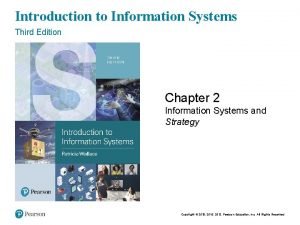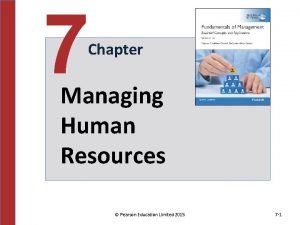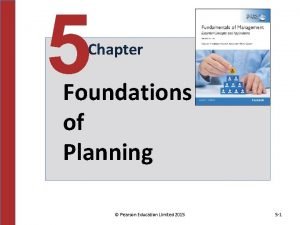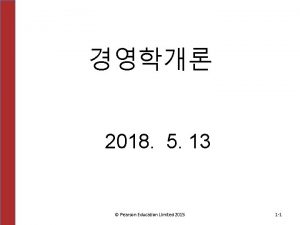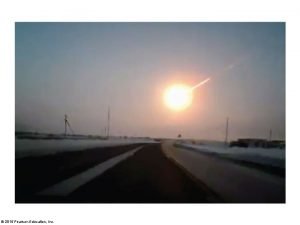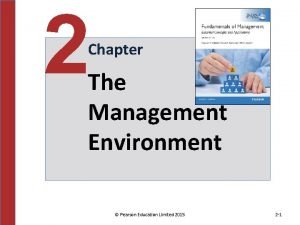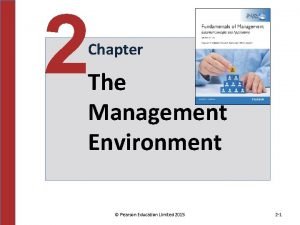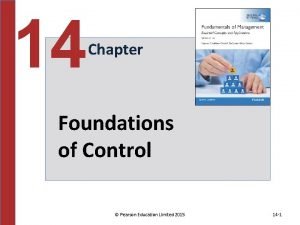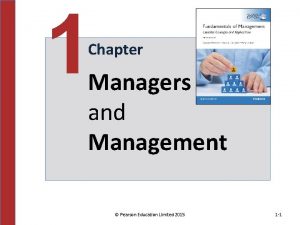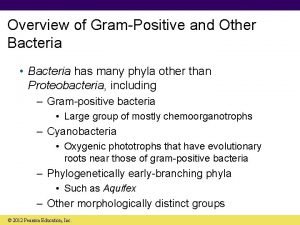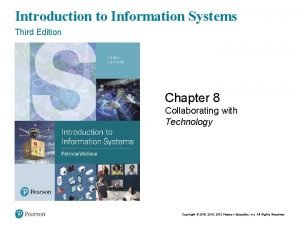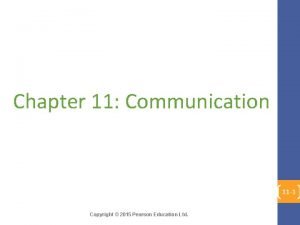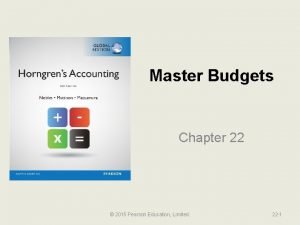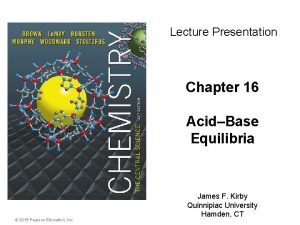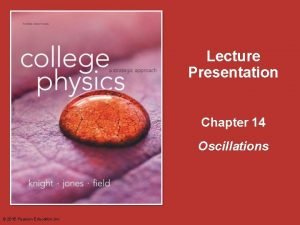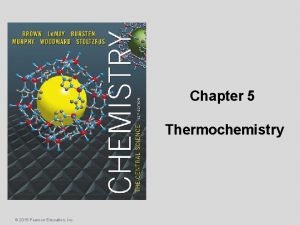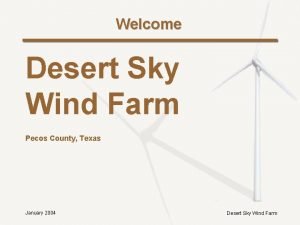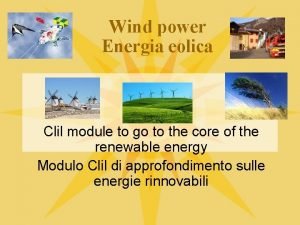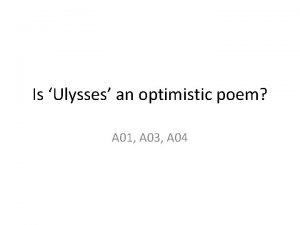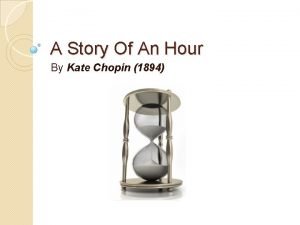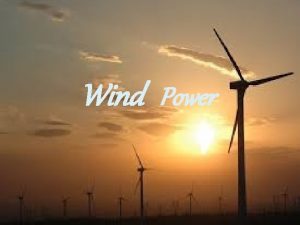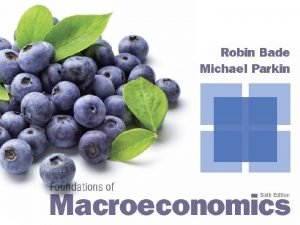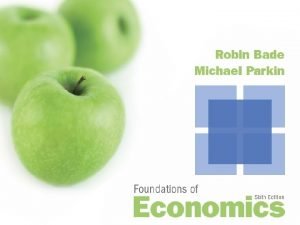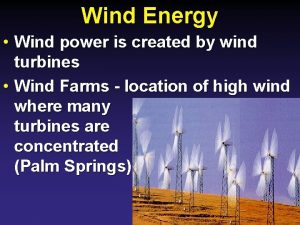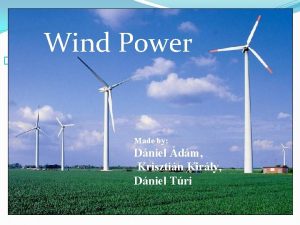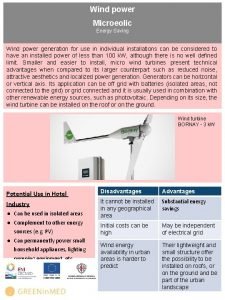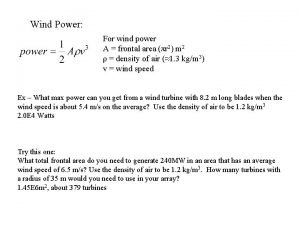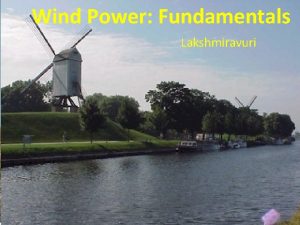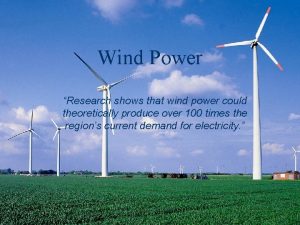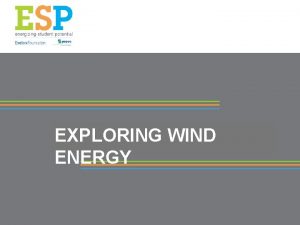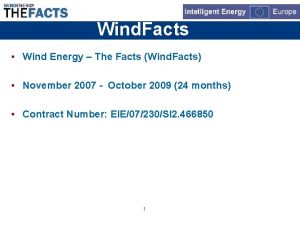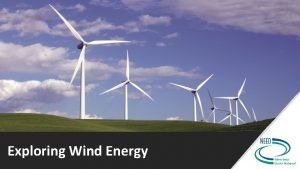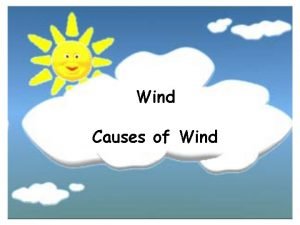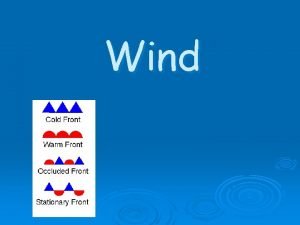2015 Pearson Is wind power free 2015 Pearson












































- Slides: 44

© 2015 Pearson

Is wind power free? © 2015 Pearson

3 The Economic Problem CHAPTER CHECKLIST When you have completed your study of this chapter, you will be able to 1 Explain and illustrate the concepts of scarcity, production efficiency, and tradeoff using the production possibilities frontier. 2 Calculate opportunity cost. 3 Explain what makes production possibilities expand. 4 Explain how people gain from trade. 5 Explain why free trade agreements are controversial © 2015 Pearson

3. 1 PRODUCTION POSSIBILITIES <Production Possibilities Frontier Production possibilities frontier The boundary between the combinations of goods and services that can be produced and the combinations that cannot be produced, given the available factors of production and the state of technology. The PPF is a valuable tool for illustrating the effects of scarcity and its consequences. © 2015 Pearson

3. 1 PRODUCTION POSSIBILITIES The PPF puts three features of production possibilities in sharp focus: • Attainable (aka feasible) and unattainable (i. e. not feasible) combinations • Efficient and inefficient production • Tradeoffs and free lunches © 2015 Pearson

3. 1 PRODUCTION POSSIBILITIES Attainable and Unattainable Combinations Because the PPF shows the limits to production, it separates attainable combinations from unattainable ones. Figure 3. 2 on the next slide illustrates the attainable and unattainable combinations. © 2015 Pearson

3. 1 PRODUCTION POSSIBILITIES We can produce at any point inside the PPF or on the frontier. We cannot produce at any point outside the PPF such as point G. The PPF separates attainable combinations from unattainable combinations. © 2015 Pearson

3. 1 PRODUCTION POSSIBILITIES Efficient and Inefficient Production efficiency is a situation in which we cannot produce more of one good or service without producing less of something else. Figure 3. 3 on the next slide illustrates the distinction between efficient and inefficient production. © 2015 Pearson

3. 1 PRODUCTION POSSIBILITIES 1. When production is on the PPF, such as at point E or D, production is efficient. 2. If production were inside the PPF, such as at point H, more could be produced of both goods without forgoing either good. Production is inefficient. © 2015 Pearson

3. 1 PRODUCTION POSSIBILITIES Tradeoffs and Free Lunches A tradeoff is an exchange—giving up one thing to get something else. A free lunch is a gift—getting something without giving up something else. Figure 3. 3 on the next slide illustrates the distinction between a tradeoff and a free lunch. © 2015 Pearson

3. 1 PRODUCTION POSSIBILITIES 3. When production is on the PPF, we face a tradeoff. 4. If production were inside the PPF, there would be a free lunch. Moving from point H to point D does not involve a tradeoff. © 2015 Pearson

3. 2 OPPORTUNITY COST <The Opportunity Cost of X The opportunity cost of good X (cell phone) is the decrease in the quantity of Y (DVDs) divided by the increase in the number of cell phones as we move along the PPF. Mathematically, opportunity cost of X is the absolute value of the slope of the PPF: © 2015 Pearson

3. 2 OPPORTUNITY COST EXAMPLE Point A B C D E F G H I © 2015 Pearson X 0 8 15 21 26 30 33 35 36 Y 72 70 66 60 52 42 30 16 0

© 2015 Pearson

Note, as the economy produces more of X, its opportunity cost rises. As we produce more Y, its opportunity cost rises. © 2015 Pearson

3. 2 OPPORTUNITY COST <The Opportunity Cost of a Cell Phone The opportunity cost of a cell phone is the decrease in the quantity of DVDs divided by the increase in the number of cell phones as we move along the PPF. Figure 3. 4 illustrates the calculation of the opportunity cost of a cell phone. © 2015 Pearson

3. 2 OPPORTUNITY COST Moving from A to B, 1 cell phone costs 1 DVD. © 2015 Pearson

3. 2 OPPORTUNITY COST Moving from B to C, 1 cell phone costs 2 DVDs. © 2015 Pearson

3. 2 OPPORTUNITY COST Moving from C to D, 1 cell phone costs 3 DVDs. © 2015 Pearson

3. 2 OPPORTUNITY COST Moving from D to E, 1 cell phone costs 4 DVDs. © 2015 Pearson

3. 2 OPPORTUNITY COST Moving from E to F, 1 cell phone costs 5 DVDs. © 2015 Pearson

3. 2 OPPORTUNITY COST Increasing Opportunity Cost The opportunity cost of a cell phone increases as more cell phones are produced. © 2015 Pearson

3. 2 OPPORTUNITY COST <Opportunity Cost and the Slope of the PPF The magnitude of the slope of the PPF measures opportunity cost. The slope of the PPF in Figure 3. 4 measures the opportunity cost of a cell phone. The PPF is bowed outward. As more cell phones are produced, the PPF becomes steeper and the opportunity cost of a cell phone increases. © 2015 Pearson

3. 2 OPPORTUNITY COST <Opportunity Cost Is a Ratio The opportunity cost of a cell phone is the quantity of DVDs forgone divided by the increase in the quantity of cell phones gained. The opportunity cost of a DVD is the quantity of cell phones forgone divided by the increase in the quantity of DVDs gained. When the opportunity cost of a cell phone is x DVDs, the opportunity cost of a DVD is 1/x cell phones. © 2015 Pearson

3. 2 OPPORTUNITY COST <Opportunity Cost Is a Ratio The opportunity cost of a X is the quantity of Y forgone divided by the increase in the quantity of X gained. © 2015 Pearson

3. 2 OPPORTUNITY COST < Increasing Opportunity Costs Are Everywhere Just about every activity has an increasing opportunity cost. If you increase the number of hours spent on studying, you will realize that after 10 hours, the gain in knowledge becomes small, and the opportunity cost (say in terms of sleep) gets high. © 2015 Pearson

Wind power is not free. Its opportunity cost includes: (1) the cost of wind turbines, (2) the cost of transmission lines, and (3) power transmission loss. Wind turbines can produce electricity only when there is wind, which is, at best, 40 percent of the time and, on average, about 25 percent of the time. Also some of the best wind farm locations are a long way from major population centers, so transmission lines would be long and power transmission losses large. © 2015 Pearson

Point A is a point of efficient electricity production. If the United States produces 55 percent of the electricity using South Dakota wind power, … the United States would be operating inside its PPF such as a point like Z. © 2015 Pearson

3. 3 ECONOMIC GROWTH Economic growth is the sustained expansion of production possibilities. An economy grows when it develops better technology, improves the quality of labor, or increases the quantity of capital. When an economy’s resources increase, its production possibilities expand its PPF shifts outward. To study economic growth, we begin at the PPF with consumption goods on one axis and a capital good on the other. © 2015 Pearson

3. 3 ECONOMIC GROWTH If we produce at point J, we produce only cellphone factories and no cell phones. If we produce at point L, we produce cell phones and no cell-phone factories. At L, consumption remains at 5 million cell phones every year. © 2015 Pearson

3. 3 ECONOMIC GROWTH 1. But if we cut production of cell phones to 3 million this year, we can produce 2 cell-phone factories at point K. 2. Then next year, our PPF shifts outward because we have more capital. We can consume at a point outside our original PPF, such as K'. © 2015 Pearson

3. 4 GAINS FROM TRADE <Main result: If people (or countries) have different relative productivity (different opportunity cost) in producing goods, then they can all gain from trading with each other (more goods can be produced). This is without working more, and without using more resources! © 2015 Pearson

3. 4 GAINS FROM TRADE <Absolute vs. Comparative Advantage <Absolute advantage - A person (or a country) has absolute advantage in producing a good if he can produce that good with less resources (say less time, less inputs). <Comparative advantage - A person (or a country) has a comparative advantage in producing a good if he can produce it at lower opportunity cost. © 2015 Pearson

3. 4 GAINS FROM TRADE <Example Nicki and Drake operate an Italian pizza bar “Anaconda”, and produce pizza and salads. Time required (in min. ) to: Opportunity Cost of one unit Make a pizza (X) Make a salad (Y) X Y Nicki 1. 5 Drake 10 2 1 5 1 1/5 • Nicki has absolute advantage in both goods. • Nicki has comparative advantage in pizza (X) and Drake has comparative advantage in salad (Y). © 2015 Pearson

3. 4 GAINS FROM TRADE <Example Same information can be given in terms of output per hour. Output per hour: Opportunity Cost of one unit Pizza (X) Salads (Y) X Y Nicki 40 40 Drake 6 30 1 5 1 1/5 • Nicki has absolute advantage in both goods. • Nicki has comparative advantage in pizza (X) and Drake has comparative advantage in salad (Y). © 2015 Pearson

3. 4 GAINS FROM TRADE Time reallocation and gains from trade 1 hour Nicki Pizza (X) Salads (Y) +40 -40 2 hours Drake Total change in output © 2015 Pearson Pizza (X) Salads (Y) -12 +60 +28 +20

3. 4 GAINS FROM TRADE <Conclusions Nicki and Drake reallocated their time towards the production of the good in which they have comparative advantage in. As a result, their total production of both goods went up. How do we gain from trade? By lowering opportunity cost. The reallocation in the example can be increases, which will increase the total gain. How much extra consumption each of them gains depends on the trade agreement. © 2015 Pearson

3. 4 GAINS FROM TRADE <Main result: If people (or countries) have different relative productivity (different opportunity cost) in producing goods, then they can all gain from trading with each other (more goods can be produced). This is without working more, and without using more resources! © 2015 Pearson

3. 5 Controversy About Free Trade Agreements NAFTA TPP Hillary Clinton Initially for, since 2008 against Initially for, since 2016 against Barack Obama Against For (created the agreement) Bernie Sanders Against Donald Trump Against Disagreements on free trade are not necessary according to political affiliation. European Union United Kingdom © 2015 Pearson In European Union since 1973. Suppose to leave the union by 2019.

3. 5 Controversy About Free Trade Agreements < We showed that the economy overall benefits from trade. However, some industries shrink, and workers lose jobs. < More trade means more production transportation of goods, and more environmental cost. This is called negative externality, and is discussed in length in micro class (ECON 101). © 2015 Pearson

3. 5 Controversy About Free Trade Agreements <Policies against free trade are costly. < "over a thousand Americans are working today because we stopped a surge in Chinese tires. “ (Barack Obama 2012, State of the Union Address, Quote about tariff increase on Chinese tires imports). < Estimated jobs saved by the tariff: 1, 200. < Cost to consumers (who spend more on tires): 1. 1 billion in 2011 alone. < Cost per job save in tire industry: $833, 000 per job. < Without the tariff, the 1. 1 billion could be spent on other goods and services, and create 11, 000 jobs (at 100 k). © 2015 Pearson

Question 1 A. Country 1 has absolute B. C. D. advantage in X. Country 2 has absolute advantage in Y. Country 1 has comparative advantage in Y. Country 2 has absolute and comparative advantage in X. © 2015 Pearson PPFs of countries 1, 2 (per worker). Y 1 2 X

Question 2 A. Country 1 has absolute B. C. D. advantage in both goods, and therefore cannot gain from trade with country 2. Country 1 has absolute advantage in both goods, but comparative advantage only in X. Country 1 has absolute advantage in both goods, but comparative advantage only in Y. Both countries have comparative advantage in X. © 2015 Pearson PPFs of countries 1, 2 (per worker). Y 1 2 X

Question 3 Which statement is incorrect? A. Neither country has comparative advantage in either good X or Y. B. County 1 has absolute advantage in both goods. C. Neither country can gain from trading with the other country. D. Neither country has absolute advantage in either good X or Y. © 2015 Pearson PPFs of countries 1, 2 (per worker). Y 1 2 X
 Kurshalter
Kurshalter Power triangle diagram
Power triangle diagram 2015 pearson education inc
2015 pearson education inc Copyright pearson education inc
Copyright pearson education inc Pearson education limited 2015
Pearson education limited 2015 Pearson education limited 2015
Pearson education limited 2015 2015 pearson education inc
2015 pearson education inc 2015 pearson education inc
2015 pearson education inc Pearson education limited 2015
Pearson education limited 2015 Pearson education limited 2008
Pearson education limited 2008 Pearson education limited 2015
Pearson education limited 2015 Pearson education limited 2015
Pearson education limited 2015 2015 pearson education inc
2015 pearson education inc Pearson education limited 2015
Pearson education limited 2015 18 / 22
18 / 22 2015 pearson education inc
2015 pearson education inc Pearson education ltd 2015
Pearson education ltd 2015 2015 pearson education inc
2015 pearson education inc Pearson education limited 2015
Pearson education limited 2015 Pearson education limited 2015
Pearson education limited 2015 Pearson 2015
Pearson 2015 Percent ionization
Percent ionization Pearson education
Pearson education 2015 pearson education inc
2015 pearson education inc 2015 pearson education inc
2015 pearson education inc Pecos wind power
Pecos wind power Advanteges of solar energy
Advanteges of solar energy Wind energy is actually an indirect form of
Wind energy is actually an indirect form of Pros and cons of wind farms
Pros and cons of wind farms Wind power energia
Wind power energia Wind power norway
Wind power norway 2011 pearson education
2011 pearson education Pearson education inc publishing as pearson prentice hall
Pearson education inc publishing as pearson prentice hall Bob whelan pearson
Bob whelan pearson Stress management for life 5th edition
Stress management for life 5th edition Pearson education inc publishing as pearson prentice hall
Pearson education inc publishing as pearson prentice hall Pearson education inc. 2012
Pearson education inc. 2012 Copyright 2008
Copyright 2008 How to calculate gibbs free energy
How to calculate gibbs free energy Gibbs free energy non standard conditions
Gibbs free energy non standard conditions How to find t in gibbs free energy
How to find t in gibbs free energy Allocating kernel memory in os
Allocating kernel memory in os Helmholtz free energy
Helmholtz free energy Happy isles ulysses
Happy isles ulysses A story of an hour summary
A story of an hour summary


